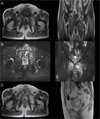Abstract
Osteomyelitis of the pubic symphysis is not common and has often been reported to occur after urological or gynecological procedures. It can be spontaneous in origin but it also is associated with trauma, athletic exertion, pregnancy, and parturition. The early symptoms of osteomyelitis of the pubic symphysis mimic those of osteitis pubis, and therefore, the differential diagnosis between these two entities is of clinical importance. A fifty nine-year-old man who had previously received debridement and wide excision of perianal necrotizing fasciitis visited our hospital with pain on both inguinal areas. The core biopsy of the pubic symphysis and aspiration culture were performed, from which Pseudomonas aeruginosa was recovered. He was treated with parenteral ceftazidime for 5 days followed by cefepime for 7 weeks and showed favorable clinical response. To our knowledge, this is the first report on osteomyelitis of pubic symphysis resulting from debridement and wide excision of perianal necrotizing fasciitis in Korea.
Figures and Tables
Figure 1
Plain radiograph of the pelvis shows slight widening of pubic symphysis with marginal bony destruction, which is more marked on the left side of the pubis.

Figure 2
A) T1-weighted MRI of the pelvis shows decreased signal within medial aspects of both pubic bones, adductor muscle, and around soft tissue, B) T2-weighted transverse MRI of the pelvis shows increased signal within medical aspects of both pubic bones, adductor muscle, and around soft tissue, C) gadolinium enhanced T1-weighted MRI of the pelvis shows decreased signal within central area with peripheral enhancement.

References
1. Smith EL, Martin RP, Matzkin E, Moyer ML. Osteomyelitis of the pubic symphysis. Orthopedics. 2003. 26:1233–1235.

2. Knoeller SM, Uhl M, Herget GW. Osteitis or osteomyelitis of the pubis? A diagnostic and therapeutic challenge: report of 9 cases and review of the literature. Acta Orthop Belg. 2006. 72:541–548.
3. Rosenthal RE, Spickard WA, Markham RD, Rhamy RK. Osteomyelitis of the symphysis pubis: a separate disease from osteitis pubis. Report of three cases and review of the literature. J Bone Joint Surg Am. 1982. 64:123–128.
4. Gil-Garay E, Fernandez-Baillo N, Martinez-Pineiro L. Osteomyelitis of the pubic symphysis due to Streptococcus anginosus. A case report. Int Orthop. 1993. 17:51–53.
5. Mader R, Yeromenco E. Pseudomonas osteomyelitis of the symphysis pubis after inguinal hernia repair. Clin Rheumatol. 1999. 18:167–169.

6. Jenkins FH, Raff MJ, Florman LD, Day TG, Templeton WC 3rd. Pubic osteomyelitis due to anaerobic bacteria. Arch Intern Med. 1984. 144:842–843.

7. Wignall TA, Carrington BM, Logue JP. Post-radiotherapy osteomyelitis of the symphysis pubis: computed tomographic features. Clin Radiol. 1998. 53:126–130.

8. del Busto R, Quinn EL, Fisher EJ, Madhavan T. Osteomyelitis of the pubis. Report of seven cases. JAMA. 1982. 248:1498–1500.

9. Karpos PA, Spindler KP, Pierce MA, Shull HJ Jr. Osteomyelitis of the pubic symphysis in athletes: a case report and literature review. Med Sci Sports Exerc. 1995. 27:473–479.
10. Lee SS, Lee KJ, Lee DH, Nam IH, Lee SE. Osteomyelitis of symphysis pubis. A case report. J Korean Orthop Assoc. 1999. 34:773–776.
11. Salahuddin NI, Madhavan T, Fisher EJ, Cox F, Quinn EL, Eyler WR. Pseudomonas osteomyelitis. Radiologic features. Radiology. 1973. 109:41–47.
12. de Miguel J, Collazos J, Ayarza R, Abaitua JM, Quilez J. Pubic osteomyelitis due to Pseudomonas aeruginosa. Clin Infect Dis. 1993. 17:515–516.




 PDF
PDF ePub
ePub Citation
Citation Print
Print




 XML Download
XML Download